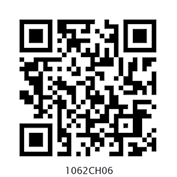Table of Contents
6
Triangles

6.1 Introduction
You are familiar with triangles and many of their properties from your earlier classes. In Class IX, you have studied congruence of triangles in detail. Recall that two figures are said to be congruent, if they have the same shape and the same size. In this chapter, we shall study about those figures which have the same shape but not necessarily the same size. Two figures having the same shape (and not necessarily the same size) are called similar figures. In particular, we shall discuss the similarity of triangles and apply this knowledge in giving a simple proof of Pythagoras Theorem learnt earlier.

Can you guess how heights of mountains (say Mount Everest) or distances of some long distant objects (say moon) have been found out? Do you think these have been measured directly with the help of a measuring tape? In fact, all these heights and distances have been found out using the idea of indirect measurements, which is based on the principle of similarity of figures (see Example 7, Q.15 of Exercise 6.3 and also Chapters 8 and 9 of this book).
6.2 Similar Figures
In Class IX, you have seen that all circles with the same radii are congruent, all squares with the same side lengths are congruent and all equilateral triangles with the same side lengths are congruent.

Fig 6.1

Fig. 6.2
Now consider any two (or more) circles [see Fig. 6.1 (i)]. Are they congruent? Since all of them do not have the same radius, they are not congruent to each other. Note that some are congruent and some are not, but all of them have the same shape. So they all are, what we call, similar. Two similar figures have the same shape but not necessarily the same size. Therefore, all circles are similar. What about two (or more) squares or two (or more) equilateral triangles [see Fig. 6.1 (ii) and (iii)]? As observed in the case of circles, here also all squares are similar and all equilateral triangles are similar.
From the above, we can say that all congruent figures are similar but the similar figures need not be congruent.
Can a circle and a square be similar? Can a triangle and a square be similar? These questions can be answered by just looking at the figures (see Fig. 6.1). Evidently these figures are not similar. (Why?)
What can you say about the two quadrilaterals ABCD and PQRS (see Fig 6.2)?Are they similar? These figures appear to be similar but we cannot be certain about it.Therefore, we must have some definition of similarity of figures and based on this definition some rules to decide whether the two given figures are similar or not. For this, let us look at the photographs given in Fig. 6.3:

Fig. 6.3
You will at once say that they are the photographs of the same monument (Taj Mahal) but are in different sizes. Would you say that the three photographs are similar? Yes,they are.
What can you say about the two photographs of the same size of the same person one at the age of 10 years and the other at the age of 40 years? Are these photographs similar? These photographs are of the same size but certainly they are not of the same shape. So, they are not similar.
What does the photographer do when she prints photographs of different sizes from the same negative? You must have heard about the stamp size, passport size and postcard size photographs. She generally takes a photograph on a small size film, say of 35mm size and then enlarges it into a bigger size, say 45mm (or 55mm). Thus, if we consider any line segment in the smaller photograph (figure), its corresponding line segment in the bigger photograph (figure) will be
 of that of the line segment. This really means that every line segment of the smaller photograph is enlarged (increased) in the ratio 35:45 (or 35:55). It can also be said that every line segment of the bigger photograph is reduced (decreased) in the ratio 45:35 (or 55:35). Further, if you consider inclinations (or angles) between any pair of corresponding line segments in the two photographs of different sizes, you shall see that these inclinations(or angles) are always equal. This is the essence of the similarity of two figures and in particular of two polygons. We say that:
of that of the line segment. This really means that every line segment of the smaller photograph is enlarged (increased) in the ratio 35:45 (or 35:55). It can also be said that every line segment of the bigger photograph is reduced (decreased) in the ratio 45:35 (or 55:35). Further, if you consider inclinations (or angles) between any pair of corresponding line segments in the two photographs of different sizes, you shall see that these inclinations(or angles) are always equal. This is the essence of the similarity of two figures and in particular of two polygons. We say that:
Two polygons of the same number of sides are similar, if (i) their corresponding angles are equal and (ii) their corresponding sides are in the same ratio (or proportion).
Note that the same ratio of the corresponding sides is referred to as the scale factor (or the Representative Fraction) for the polygons. You must have heard that world maps (i.e., global maps) and blue prints for the construction of a building are prepared using a suitable scale factor and observing certain conventions.
In order to understand similarity of figures more clearly, let us perform the following activity:
Activity 1 :
Place a lighted bulb at a point O on the ceiling and directly below it a table in your classroom. Let us cut a polygon, say a quadrilateral ABCD, from a plane cardboard and place this cardboard parallel to the ground between the lighted bulb and the table. Then a shadow of ABCD is cast on the table. Mark the outline of this shadow as A′B′C′D′ (see Fig.6.4).

Fig. 6.4
Note that the quadrilateral A′B′C′D′ is an enlargement (or magnification) of the quadrilateral ABCD. This is because of the property of light that light propogates in a straight line. You may also note that A′ lies on ray OA, B′ lies on ray OB, C′ lies on OC and D′ lies on OD. Thus, quadrilaterals A′B′C′D′ and ABCD are of the same shape but of different sizes.
So, quadrilateral A′B′C′D′ is similiar to quadrilateral ABCD. We can also say that quadrilateral ABCD is similar to the quadrilateral A′B′C′D′.
Here, you can also note that vertex A′ corresponds to vertex A, vertex B′ corresponds to vertex B, vertex C′ corresponds to vertex C and vertex D′ corresponds to vertex D. Symbolically, these correspondences are represented as A′ ↔ A, B′ ↔ B, C′ ↔ C and D′ ↔ D. By actually measuring the angles and the sides of the two quadrilaterals, you may verify that
(i) ∠ A = ∠ A′, ∠ B = ∠ B′, ∠ C = ∠ C′, ∠ D = ∠ D′ and
(ii)  .
.
This again emphasises that two polygons of the same number of sides are similar, if (i) all the corresponding angles are equal and (ii) all the corresponding sides are in the same ratio (or proportion).
From the above, you can easily say that quadrilaterals ABCD and PQRS of Fig. 6.5 are similar.

Fig. 6.5
Remark :
You can verify that if one polygon is similar to another polygon and this second polygon is similar to a third polygon, then the first polygon is similar to the third polygon.
You may note that in the two quadrilaterals (a square and a rectangle) of Fig. 6.6, corresponding angles are equal, but their corresponding sides are not in the same ratio.

Fig. 6.6
So, the two quadrilaterals are not similar. Similarly, you may note that in the two quadrilaterals (a square and a rhombus) of Fig. 6.7, corresponding sides are in the same ratio, but their corresponding angles are not equal. Again, the two polygons (quadrilaterals) are not similar.

Fig. 6.7
Thus, either of the above two conditions (i) and (ii) of similarity of two polygons is not sufficient for them to be similar.
Exercise 6.1
1. Fill in the blanks using the correct word given in brackets :
(i) All circles are  . (congruent, similar)
. (congruent, similar)
(ii) All squares are  . (similar, congruent)
. (similar, congruent)
(iii) All  triangles are similar. (isosceles, equilateral)
triangles are similar. (isosceles, equilateral)
(iv) Two polygons of the same number of sides are similar, if (a) their corresponding angles are  and (b) their corresponding sides are
and (b) their corresponding sides are  .(equal, proportional)
.(equal, proportional)
2. Give two different examples of pair of
(i) similar figures. (ii) non-similar figures.
3. State whether the following quadrilaterals are similar or not:

Fig. 6.8
6.3 Similarity of Triangles
What can you say about the similarity of two triangles?
You may recall that triangle is also a polygon. So, we can state the same conditions for the similarity of two triangles. That is:
Two triangles are similiar, if
(i) their corresponding angles are equal and
(ii) their corresponding sides are in the same ratio (or proportion).
Note that if corresponding angles of two triangles are equal, then they are known as equiangular triangles. A famous Greek mathematician Thales gave an important truth relating to two equiangular triangles which is as follows:

Thales (640 – 546 B.C.)
Activity 2 :
Draw any angle XAY and on its one arm AX, mark points (say five points) P, Q, D, R and B such that AP = PQ = QD = DR = RB.

Fig. 6.9
Now, through B, draw any line intersecting arm AY at C (see Fig. 6.9).
Also, through the point D, draw a line parallel to BC to intersect AC at E. Do you observe from your constructions that  ? Measure AE and EC. What about
? Measure AE and EC. What about  ? Observe that
? Observe that  is also equal to
is also equal to  . Thus, you can see that in ∆ ABC, DE || BC and
. Thus, you can see that in ∆ ABC, DE || BC and  . Is it a coincidence? No, it is due to the following theorem (known as the Basic Proportionality Theorem):
. Is it a coincidence? No, it is due to the following theorem (known as the Basic Proportionality Theorem):
Theorem 6.1 :
If a line is drawn parallel to one side of a triangle to intersect the other two sides in distinct points, the other two sides are divided in the same ratio.
Proof :
We are given a triangle ABC in which a line parallel to side BC intersects other two sides AB and AC at D and E respectively (see Fig. 6.10).

Fig. 6.10
We need to prove that  .
.
Let us join BE and CD and then draw DM ⊥ AC and EN ⊥ AB.
Now, area of ∆ ADE (=  base × height) =
base × height) =  AD × EN.
AD × EN.
Recall from Class IX, that area of ∆ ADE is denoted as ar(ADE).
So, ar(ADE) =  AD × EN
AD × EN
Similarly, ar(BDE) =  DB × EN,
DB × EN,
ar(ADE) =  AE × DM and ar(DEC) =
AE × DM and ar(DEC) =  EC × DM.
EC × DM.
Therefore,  =
=  (1)
(1)
and  =
=  (2)
(2)
Note that ∆ BDE and DEC are on the same base DE and between the same parallels BC and DE.
So, ar(BDE) = ar(DEC) (3)
Therefore, from (1), (2) and (3), we have :
 =
= 
Is the converse of this theorem also true (For the meaning of converse, see Appendix 1)? To examine this, let us perform the following activity:
Activity 3 :
Draw an angle XAY on your notebook and on ray AX, mark points B1, B2, B3, B4 and B such that AB1 = B1B2 = B2B3 = B3B4 = B4B.
Similarly, on ray AY, mark points
C1, C2, C3, C4 and C such that AC1 = C1C2 = C2C3 = C3C4 = C4C. Then join B1C1 and BC
(see Fig. 6.11).
Note that  =
=  (Each equal to
(Each equal to  )
)
You can also see that lines B1C1 and BC are parallel to each other, i.e.,

Fig. 6.11
B1C1 || BC (1)
Similarly, by joining B2C2, B3C3 and B4C4, you can see that:
 =
= 
 and B2C2 || BC (2)
and B2C2 || BC (2)
 =
= 
 and B3C3 || BC (3)
and B3C3 || BC (3)
 =
= 
 and B4C4 || BC (4)
and B4C4 || BC (4)
From (1), (2), (3) and (4), it can be observed that if a line divides two sides of a triangle in the same ratio, then the line is parallel to the third side.
You can repeat this activity by drawing any angle XAY of different measure and taking any number of equal parts on arms AX and AY . Each time, you will arrive at the same result. Thus, we obtain the following theorem, which is the converse of Theorem 6.1:
Theorem 6.2 :
If a line divides any two sides of a triangle in the same ratio, then the line is parallel to the third side.
This theorem can be proved by taking a line DE such that  and assuming that DE is not parallel to BC (see Fig. 6.12).
and assuming that DE is not parallel to BC (see Fig. 6.12).

Fig. 6.12
If DE is not parallel to BC, draw a line DE′ parallel to BC.
So,  =
=  (Why ?)
(Why ?)
Therefore,  =
=  (Why ?)
(Why ?)
Adding 1 to both sides of above, you can see that E and E′ must coincide. (Why ?)
Let us take some examples to illustrate the use of the above theorems.
Example 1 :
If a line intersects sides AB and AC of a ∆ ABC at D and E respectively and is parallel to BC, prove that  =
=  (see Fig. 6.13).
(see Fig. 6.13).

Solution :
DE || BC (Given)
So,  =
=  (Theorem 6.1)
(Theorem 6.1)
or,  =
= 
or,  =
= 
or,  =
= 
So,  =
= 
Example 2 :
ABCD is a trapezium with AB || DC. E and F are points on non-parallel sides AD and BC respectively such that EF is parallel to AB (see Fig. 6.14). Show that  .
.

Fig. 6.16
Solution :
Let us join AC to intersect EF at G (see Fig. 6.15).

Fig. 6.15
AB || DC and EF || AB (Given)
So, EF || DC (Lines parallel to the same line are parallel to each other)
EG || DC (As EF || DC)
So,  =
=  (Theorem 6.1) (1)
(Theorem 6.1) (1)
Similarly, from ∆ CAB,
 =
= 
i.e.,  =
=  (2)
(2)
Therefore, from (1) and (2),
 =
= 
Example 3 :
In Fig. 6.16,  =
=  and ∠ PST = ∠ PRQ. Prove that PQR is an isosceles triangle.
and ∠ PST = ∠ PRQ. Prove that PQR is an isosceles triangle.

Solution :
t is given that 
So, ST || QR (Theorem 6.2)
Therefore, ∠ PST = ∠ PQR (Corresponding angles) (1)
Also, it is given that
∠ PST = ∠ PRQ (2)
So, ∠ PRQ = ∠ PQR [From (1) and (2)]
Therefore, PQ = PR (Sides opposite the equal angles)
i.e., PQR is an isosceles triangle.
Exercise 6.2
1. In Fig. 6.17, (i) and (ii), DE || BC. Find EC in (i) and AD in (ii).

Fig. 6.17
2. E and F are points on the sides PQ and PR respectively of a ∆ PQR. For each of the following cases, state whether EF || QR :

Fig. 6.18
(i) PE = 3.9 cm, EQ = 3 cm, PF = 3.6 cm and FR = 2.4 cm
(ii) PE = 4 cm, QE = 4.5 cm, PF = 8 cm and RF = 9 cm
(iii) PQ = 1.28 cm, PR = 2.56 cm, PE = 0.18 cm and PF = 0.36 cm
3. In Fig. 6.18, if LM || CB and LN || CD, prove that 
4. In Fig. 6.19, DE || AC and DF || AE. Prove that 
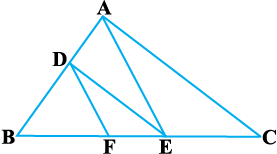
Fig. 6.19
5. In Fig. 6.20, DE || OQ and DF || OR. Show that EF || QR.
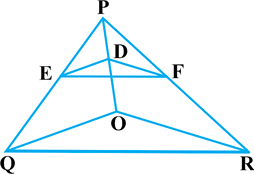
Fig. 6.20
6. In Fig. 6.21, A, B and C are points on OP, OQ and OR respectively such that AB || PQ and AC || PR. Show that BC || QR.
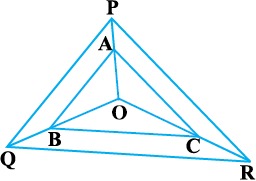
Fig. 6.21
7. Using Theorem 6.1, prove that a line drawn through the mid-point of one side of a triangle parallel to another side bisects the third side. (Recall that you have proved it in Class IX).
8. Using Theorem 6.2, prove that the line joining the mid-points of any two sides of a triangle is parallel to the third side. (Recall that you have done it in Class IX).
9. ABCD is a trapezium in which AB || DC and its diagonals intersect each other at the point O. Show that 
10. The diagonals of a quadrilateral ABCD intersect each other at the point O such that  Show that ABCD is a trapezium.
Show that ABCD is a trapezium.
6.4 Criteria for Similarity of Triangles
In the previous section, we stated that two triangles are similar, if (i) their corresponding angles are equal and (ii) their corresponding sides are in the same ratio (or proportion).
That is, in ∆ ABC and ∆ DEF, if
(i) ∠ A = ∠ D, ∠ B = ∠ E, ∠ C = ∠ F and
(ii)  then the two triangles are similar (see Fig. 6.22).
then the two triangles are similar (see Fig. 6.22).

Fig. 6.22
Here, you can see that A corresponds to D, B corresponds to E and C corresponds to F. Symbolically, we write the similarity of these two triangles as ‘∆ ABC ~ ∆ DEF’ and read it as ‘triangle ABC is similar to triangle DEF’. The symbol ‘~’ stands for ‘is similar to’. Recall that you have used the symbol ‘≅’ for ‘is congruent to’ in Class IX.
It must be noted that as done in the case of congruency of two triangles, the similarity of two triangles should also be expressed symbolically, using correct correspondence of their vertices. For example, for the triangles ABC and DEF of Fig. 6.22, we cannot write ∆ ABC ~ ∆ EDF or ∆ ABC ~ ∆ FED. However, we can write ∆ BAC ~ ∆ EDF.
Now a natural question arises : For checking the similarity of two triangles, say ABC and DEF, should we always look for all the equality relations of their corresponding angles (∠ A = ∠ D, ∠ B = ∠ E, ∠ C = ∠ F) and all the equality relations of the ratios of their corresponding sides  ? Let us examine. You may recall that in Class IX, you have obtained some criteria for congruency of two triangles involving only three pairs of corresponding parts (or elements) of the two triangles. Here also, let us make an attempt to arrive at certain criteria for similarity of two triangles involving relationship between less number of pairs of corresponding parts of the two triangles, instead of all the six pairs of corresponding parts. For this, let us perform the following activity:
? Let us examine. You may recall that in Class IX, you have obtained some criteria for congruency of two triangles involving only three pairs of corresponding parts (or elements) of the two triangles. Here also, let us make an attempt to arrive at certain criteria for similarity of two triangles involving relationship between less number of pairs of corresponding parts of the two triangles, instead of all the six pairs of corresponding parts. For this, let us perform the following activity:
Activity 4 :
Draw two line segments BC and EF of two different lengths, say 3 cm and 5 cm respectively. Then, at the points B and C respectively, construct angles PBC and QCB of some measures, say, 60° and 40°. Also, at the points E and F, construct angles REF and SFE of 60° and 40° respectively (see Fig. 6.23).
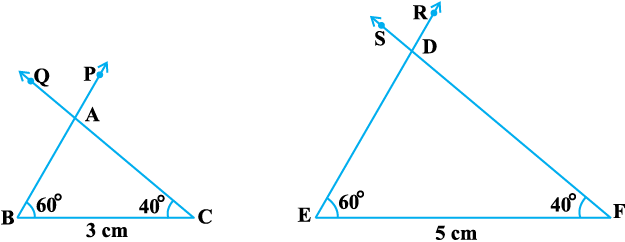
Fig. 6.23
Let rays BP and CQ intersect each other at A and rays ER and FS intersect each other at D. In the two triangles ABC and DEF, you can see that
∠ B = ∠ E, ∠ C = ∠ F and ∠ A = ∠ D. That is, corresponding angles of these two triangles are equal. What can you say about their corresponding sides ? Note that  What about
What about  and
and  ? On measuring AB, DE, CA and FD, you will find that
? On measuring AB, DE, CA and FD, you will find that  and
and  are also equal to 0.6 (or nearly equal to 0.6, if there is some error in the measurement). Thus,
are also equal to 0.6 (or nearly equal to 0.6, if there is some error in the measurement). Thus,  You can repeat this activity by constructing several pairs of triangles having their corresponding angles equal. Every time, you will find that their corresponding sides are in the same ratio (or proportion). This activity leads us to the following criterion for similarity of two triangles.
You can repeat this activity by constructing several pairs of triangles having their corresponding angles equal. Every time, you will find that their corresponding sides are in the same ratio (or proportion). This activity leads us to the following criterion for similarity of two triangles.
Theorem 6.3 :
If in two triangles, corresponding angles are equal, then their corresponding sides are in the same ratio (or proportion) and hence the two triangles are similar.
This criterion is referred to as the AAA (Angle–Angle–Angle) criterion of similarity of two triangles.
This theorem can be proved by taking two triangles ABC and DEF such that ∠ A = ∠ D, ∠ B = ∠ E and ∠ C = ∠ F
(see Fig. 6.24)
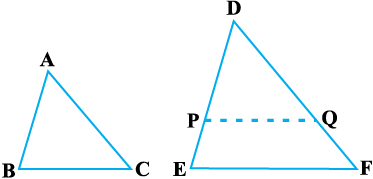
Fig. 6.24
Cut DP = AB and DQ = AC and join PQ.
So, ∆ ABC ≅ ∆ DPQ (Why ?)
This gives ∠ B = ∠ P = ∠ E and PQ || EF (How?)
Therefore,  =
=  (Why?)
(Why?)
i.e.,  =
=  (Why?)
(Why?)
Similarly,  =
=  and so
and so  .
.
Remark :
If two angles of a triangle are respectively equal to two angles of another triangle, then by the angle sum property of a triangle their third angles will also be equal. Therefore, AAA similarity criterion can also be stated as follows:
If two angles of one triangle are respectively equal to two angles of another triangle, then the two triangles are similar.
This may be referred to as the AA similarity criterion for two triangles.
You have seen above that if the three angles of one triangle are respectively equal to the three angles of another triangle, then their corresponding sides are proportional (i.e., in the same ratio). What about the converse of this statement? Is the converse true? In other words, if the sides of a triangle are respectively proportional to the sides of another triangle, is it true that their corresponding angles are equal? Let us examine it through an activity :
Activity 5 :
Draw two triangles ABC and DEF such that AB = 3 cm, BC = 6 cm, CA = 8 cm, DE = 4.5 cm, EF = 9 cm and FD = 12 cm (see Fig. 6.25).

Fig. 6.25
So, you have :  (each equal to
(each equal to  )
)
Now measure ∠ A, ∠ B, ∠ C, ∠ D, ∠ E and ∠ F. You will observe that
∠ A = ∠ D, ∠ B = ∠ E and ∠ C = ∠ F, i.e., the corresponding angles of the two triangles are equal.
You can repeat this activity by drawing several such triangles (having their sides in the same ratio). Everytime you shall see that their corresponding angles are equal. It is due to the following criterion of similarity of two triangles:
Theorem 6.4 :
If in two triangles, sides of one triangle are proportional to (i.e., in the same ratio of) the sides of the other triangle, then their corresponding angles are equal and hence the two triangles are similiar.
This criterion is referred to as the SSS (Side–Side–Side) similarity criterion for two triangles.
This theorem can be proved by taking two triangles ABC and DEF such that  (< 1) (see Fig. 6.26):
(< 1) (see Fig. 6.26):
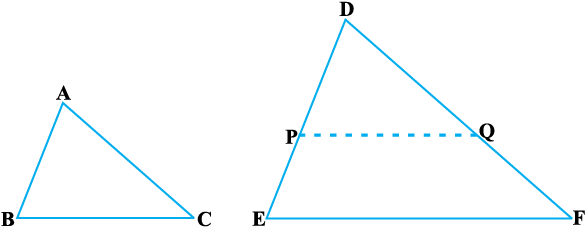
Fig. 6.26
Cut DP = AB and DQ = AC and join PQ.
It can be seen that  =
=  and PQ || EF (How?)
and PQ || EF (How?)
So, ∠ P = ∠ E and ∠ Q = ∠ F.
Therefore,  =
=  =
= 
So,  =
=  =
=  (Why?)
(Why?)
So, BC = PQ (Why?)
Thus, ∆ ABC ≅ ∆ DPQ (Why ?)
So, ∠ A = ∠ D, ∠ B = ∠ E and ∠ C = ∠ F (How ?)
Remark :
You may recall that either of the two conditions namely, (i) corresponding angles are equal and (ii) corresponding sides are in the same ratio is not sufficient for two polygons to be similar. However, on the basis of Theorems 6.3 and 6.4, you can now say that in case of similarity of the two triangles, it is not necessary to check both the conditions as one condition implies the other.
Let us now recall the various criteria for congruency of two triangles learnt in Class IX. You may observe that SSS similarity criterion can be compared with the SSS congruency criterion.This suggests us to look for a similarity criterion comparable to SAS congruency criterion of triangles. For this, let us perform an activity.
Activity 6 :
Draw two triangles ABC and DEF such that AB = 2 cm, ∠ A = 50°, AC = 4 cm, DE = 3 cm, ∠ D = 50° and DF = 6 cm (see Fig.6.27).

Fig. 6.27
Here, you may observe that  =
=  (each equal to
(each equal to  ) and ∠ A (included between the sides AB and AC) = ∠ D (included between the sides DE and DF). That is, one angle of a triangle is equal to one angle of another triangle and sides including these angles are in the same ratio (i.e., proportion). Now let us measure ∠ B, ∠ C, ∠ E and ∠ F.
) and ∠ A (included between the sides AB and AC) = ∠ D (included between the sides DE and DF). That is, one angle of a triangle is equal to one angle of another triangle and sides including these angles are in the same ratio (i.e., proportion). Now let us measure ∠ B, ∠ C, ∠ E and ∠ F.
You will find that ∠ B = ∠ E and ∠ C = ∠ F. That is, ∠ A = ∠ D, ∠ B = ∠ E and ∠ C = ∠ F. So, by AAA similarity criterion, ∆ ABC ~ ∆ DEF. You may repeat this activity by drawing several pairs of such triangles with one angle of a triangle equal to one angle of another triangle and the sides including these angles are proportional. Everytime, you will find that the triangles are similar. It is due to the following criterion of similarity of triangles:
Theorem 6.5 :
If one angle of a triangle is equal to one angle of the other triangle and the sides including these angles are proportional, then the two triangles are similar.
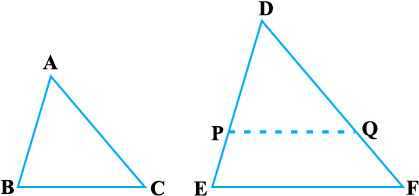
Fig. 6.28
This criterion is referred to as the SAS (Side–Angle–Side) similarity criterion for two triangles.
As before, this theorem can be proved by taking two triangles ABC and DEF such that  (< 1) and ∠ A = ∠ D (see Fig. 6.28). Cut DP = AB, DQ = AC and join PQ.
(< 1) and ∠ A = ∠ D (see Fig. 6.28). Cut DP = AB, DQ = AC and join PQ.
Now, PQ || EF and ∆ ABC ≅ ∆ DPQ (How ?)
So, ∠ A = ∠ D, ∠ B = ∠ P and ∠ C = ∠ Q
Therefore, ∆ ABC ~ ∆ DEF (Why?)
We now take some examples to illustrate the use of these criteria.
Example 4 :
In Fig. 6.29, if PQ || RS, prove that ∆ POQ ~ ∆ SOR.
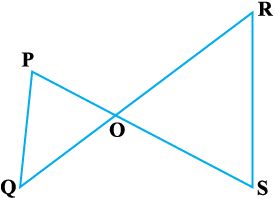
Fig. 6.29
Solution :
PQ || RS (Given)
So, ∠ P = ∠ S (Alternate angles)
and ∠ Q = ∠ R
Also, ∠ POQ = ∠ SOR (Vertically opposite angles)
Therefore, ∆ POQ ~ ∆ SOR (AAA similarity criterion)
Example 5 :
Observe Fig. 6.30 and then find ∠ P.
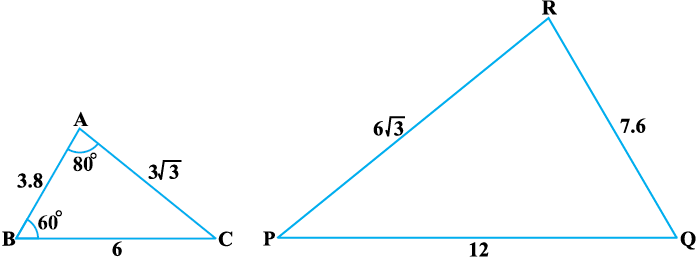
Fig. 6.30
Solution :
In ∆ ABC and ∆ PQR,

 and
and 
That is, 
So, ∆ ABC ~ ∆ RQP (SSS similarity)
Therefore, ∠ C = ∠ P (Corresponding angles of similar triangles)
But ∠ C = 180° – ∠ A – ∠ B (Angle sum property)
= 180° – 80° – 60° = 40°
So, ∠ P = 40°
Example 6 :
In Fig. 6.31,
OA . OB = OC . OD.
Show that ∠ A = ∠ C and ∠ B = ∠ D.
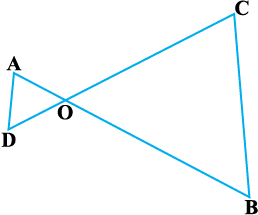
Fig. 6.31
Solution :
OA . OB = OC . OD (Given)
So,  =
=  (1)
(1)
Also, we have ∠ AOD = ∠ COB (Vertically opposite angles) (2)
Therefore, from (1) and (2), ∆ AOD ~ ∆ COB (SAS similarity criterion)
So, ∠ A = ∠ C and ∠ D = ∠ B
(Corresponding angles of similar triangles)
Example 7 :
A girl of height 90 cm is walking away from the base of a lamp-post at a speed of 1.2 m/s. If the lamp is 3.6 m above the ground, find the length of her shadow after 4 seconds.
Solution :
Let AB denote the lamp-post and CD the girl after walking for 4 seconds away from the lamp-post (see Fig. 6.32).
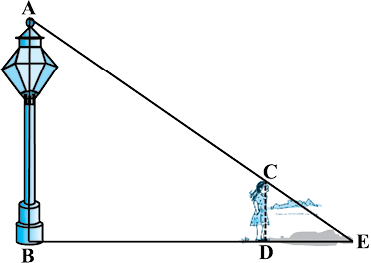
Fig. 6.32
From the figure, you can see that DE is the shadow of the girl. Let DE be x metres.
Now, BD = 1.2 m × 4 = 4.8 m.
Note that in ∆ ABE and ∆ CDE,
∠ B = ∠ D (Each is of 90° because lamp-post as well as the girl are standing vertical to the ground)
and ∠ E = ∠ E (Same angle)
So, ∆ ABE ~ ∆ CDE (AA similarity criterion)
Therefore,  =
= 
i.e.,  =
=  (90 cm =
(90 cm =  m = 0.9 m)
m = 0.9 m)
i.e., 4.8 + x = 4x
i.e., 3x = 4.8
i.e., x = 1.6
So, the shadow of the girl after walking for 4 seconds is 1.6 m long.
Example 8 :
In Fig. 6.33, CM and RN are respectively the medians of ∆ ABC and
∆ PQR. If ∆ ABC ~ ∆ PQR, prove that :
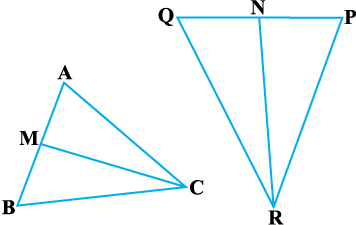
Fig. 6.33
(i) ∆ AMC ~ ∆ PNR
(ii) 
(iii) ∆ CMB ~ ∆ RNQ
Solution :
(i) ∆ ABC ~ ∆ PQR (Given)
So,  =
=  (1)
(1)
and ∠ A = ∠ P, ∠ B = ∠ Q and ∠ C = ∠ R (2)
But AB = 2 AM and PQ = 2 PN
(As CM and RN are medians)
So, from (1),  =
= 
i.e.,  =
=  (3)
(3)
Also, ∠ MAC = ∠ NPR [From (2)] (4)
So, from (3) and (4),
∆ AMC ~ ∆ PNR (SAS similarity) (5)
(ii) From (5),  =
=  (6)
(6)
But  =
=  [From (1)] (7)
[From (1)] (7)
Therefore,  =
=  [From (6) and (7)] (8)
[From (6) and (7)] (8)
(iii) Again,  =
=  [From (1)]
[From (1)]
Therefore,  =
=  [From (8)] (9)
[From (8)] (9)
Also,  =
= 
i.e.,  =
=  (10)
(10)
i.e.,  =
=  [From (9) and (10)]
[From (9) and (10)]
Therefore, ∆ CMB ~ ∆ RNQ (SSS similarity)
[Note : You can also prove part (iii) by following the same method as used for proving part (i).]
Exercise 6.3
1. State which pairs of triangles in Fig. 6.34 are similar. Write the similarity criterion used by you for answering the question and also write the pairs of similar triangles in the symbolic form :
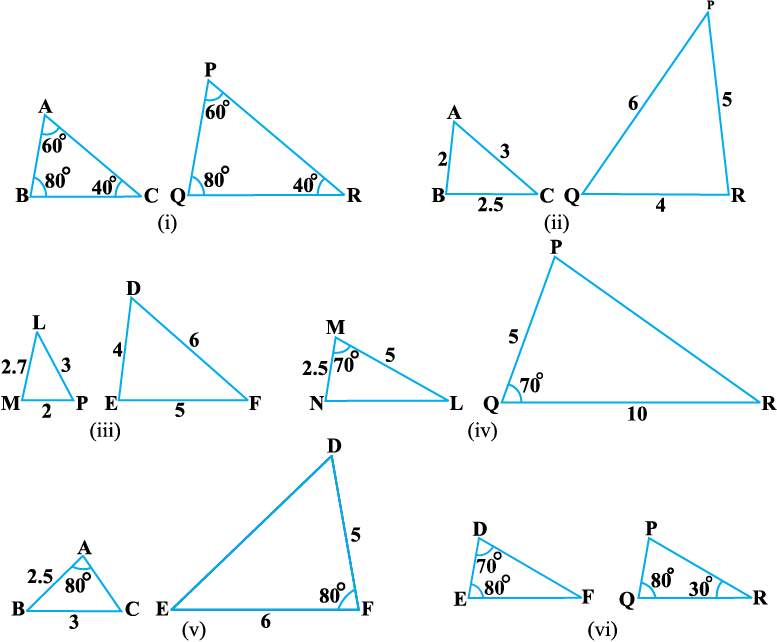
Fig. 6.34
2. In Fig. 6.35, ∆ ODC ~ ∆ OBA, ∠ BOC = 125° and ∠ CDO = 70°. Find ∠ DOC, ∠ DCO and ∠ OAB.
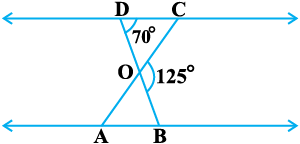
Fig. 6.35
3. Diagonals AC and BD of a trapezium ABCD with AB || DC intersect each other at the point O. Using a similarity criterion for two triangles, show that 
4. In Fig. 6.36,  and ∠ 1 = ∠ 2. Show that ∆ PQS ~ ∆ TQR.
and ∠ 1 = ∠ 2. Show that ∆ PQS ~ ∆ TQR.
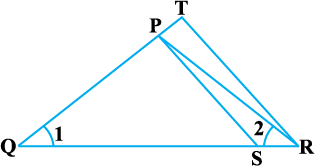
Fig. 6.36
5. S and T are points on sides PR and QR of
∆ PQR such that ∠ P = ∠ RTS. Show that
∆ RPQ ~ ∆ RTS.
6. In Fig. 6.37, if ∆ ABE ≅ ∆ ACD, show that ∆ ADE ~ ∆ ABC.
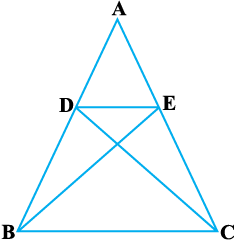
Fig. 6.37
7. In Fig. 6.38, altitudes AD and CE of ∆ ABC intersect each other at the point P. Show that:
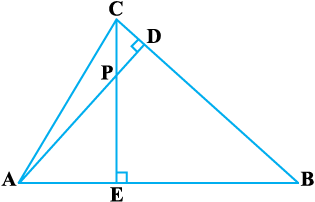
Fig. 6.38
(i) ∆ AEP ~ ∆ CDP
(ii) ∆ ABD ~ ∆ CBE
(iii) ∆ AEP ~ ∆ ADB
(iv) ∆ PDC ~ ∆ BEC
8. E is a point on the side AD produced of a parallelogram ABCD and BE intersects CD at F. Show that ∆ ABE ~ ∆ CFB.
9. In Fig. 6.39, ABC and AMP are two right triangles, right angled at B and M respectively. Prove that:

Fig. 6.39
(i) ∆ ABC ~ ∆ AMP
(ii) 
10. CD and GH are respectively the bisectors of ∠ ACB and ∠ EGF such that D and H lie on sides AB and FE of ∆ ABC and ∆ EFG respectively. If ∆ ABC ~ ∆ FEG, show that:
(i) 
(ii) ∆ DCB ~ ∆ HGE
(iii) ∆ DCA ~ ∆ HGF
11. In Fig. 6.40, E is a point on side CB produced of an isosceles triangle ABC with AB = AC. If AD ⊥ BC and EF ⊥ AC, prove that ∆ ABD ~ ∆ ECF.
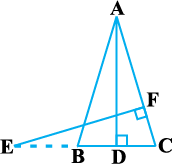
Fig. 6.40
12. Sides AB and BC and median AD of a triangle ABC are respectively propor-tional to sides PQ and QR and median PM of ∆ PQR (see Fig. 6.41). Show that ∆ ABC ~ ∆ PQR.

Fig. 6.41
13. D is a point on the side BC of a triangle ABC such that ∠ ADC = ∠ BAC. Show that CA2 = CB.CD.
14. Sides AB and AC and median AD of a triangle ABC are respectively proportional to sides PQ and PR and median PM of another triangle PQR. Show that ∆ ABC ~ ∆ PQR.
15. A vertical pole of length 6 m casts a shadow 4 m long on the ground and at the same time a tower casts a shadow 28 m long. Find the height of the tower.
16. If AD and PM are medians of triangles ABC and PQR, respectively where ∆ ABC ~ ∆ PQR, prove that 
6.5 Areas of Similar Triangles
You have learnt that in two similar triangles, the ratio of their corresponding sides is the same. Do you think there is any relationship between the ratio of their areas and the ratio of the corresponding sides? You know that area is measured in square units. So, you may expect that this ratio is the square of the ratio of their corresponding sides. This is indeed true and we shall prove it in the next theorem.
Theorem 6.6 :
The ratio of the areas of two similar triangles is equal to the square of the ratio of their corresponding sides.
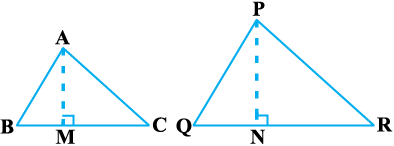
Fig. 6.42
Proof :
We are given two triangles ABC and PQR such that ∆ ABC ~ ∆ PQR (see Fig. 6.42).
We need to prove that 
For finding the areas of the two triangles, we draw altitudes AM and PN of the triangles.
Now, ar (ABC) = 
and ar (PQR) = 
So,  =
=  (1)
(1)
Now, in ∆ ABM and ∆ PQN,
∠ B = ∠ Q (As ∆ ABC ~ ∆ PQR)
and ∠ M = ∠ N (Each is of 90°)
So, ∆ ABM ~ ∆ PQN (AA similarity criterion)
Therefore,  =
=  (2)
(2)
Also, ∆ ABC ~ ∆ PQR (Given)
So,  =
=  (3)
(3)
Therefore,  =
=  [From (1) and (3)]
[From (1) and (3)]
=  [From (2)]
[From (2)]
= 
Now using (3), we get
 =
= 
Let us take an example to illustrate the use of this theorem.
Example 9 :
In Fig. 6.43, the line segment XY is parallel to side AC of ∆ ABC and it divides the triangle into two parts of equal areas. Find the ratio 
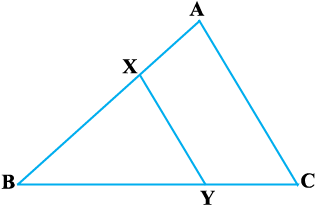
Fig. 6.43
Solution :
We have XY || AC (Given)
So, ∠ BXY = ∠ A and ∠ BYX = ∠ C (Corresponding angles)
Therefore, ∆ ABC ~ ∆ XBY (AA similarity criterion)
So,  =
=  (Theorem 6.6) (1)
(Theorem 6.6) (1)
Also, ar (ABC) = 2 ar (XBY) (Given)
So,  =
=  (2)
(2)
Therefore, from (1) and (2),
 , i.e.,
, i.e., 
or,  =
= 
or,  =
= 
or,  , i.e.,
, i.e.,  =
=  .
.
Exercise 6.4
1. Let ∆ ABC ~ ∆ DEF and their areas be, respectively, 64 cm2 and 121 cm2. If EF = 15.4 cm, find BC.
2. Diagonals of a trapezium ABCD with AB || DC intersect each other at the point O. If AB = 2 CD, find the ratio of the areas of triangles AOB and COD.
3. In Fig. 6.44, ABC and DBC are two triangles on the same base BC. If AD intersects BC at O, show that 
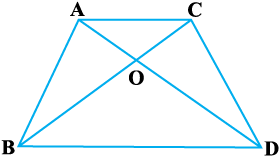
Fig. 6.44
4. If the areas of two similar triangles are equal, prove that they are congruent.
5. D, E and F are respectively the mid-points of sides AB, BC and CA of ∆ ABC. Find the ratio of the areas of ∆ DEF and ∆ ABC.
6. Prove that the ratio of the areas of two similar triangles is equal to the square of the ratio of their corresponding medians.
7. Prove that the area of an equilateral triangle described on one side of a square is equal to half the area of the equilateral triangle described on one of its diagonals.
Tick the correct answer and justify :
8. ABC and BDE are two equilateral triangles such that D is the mid-point of BC. Ratio of the areas of triangles ABC and BDE is
(A) 2 : 1 (B) 1 : 2 (C) 4 : 1 (D) 1 : 4
9. Sides of two similar triangles are in the ratio 4 : 9. Areas of these triangles are in the ratio
(A) 2 : 3 (B) 4 : 9 (C) 81 : 16 (D) 16 : 81
6.6 Pythagoras Theorem
You are already familiar with the Pythagoras Theorem from your earlier classes. You had verified this theorem through some activities and made use of it in solving certain problems. You have also seen a proof of this theorem in Class IX. Now, we shall prove this theorem using the concept of similarity of triangles. In proving this, we shall make use of a result related to similarity of two triangles formed by the perpendicular to the hypotenuse from the opposite vertex of the right triangle.
Now, let us take a right triangle ABC, right angled at B. Let BD be the perpendicular to the hypotenuse AC (see Fig. 6.45).

Fig. 6.45
You may note that in ∆ ADB and ∆ ABC
∠ A = ∠ A
and ∠ ADB = ∠ ABC (Why?)
So, ∆ ADB ~ ∆ ABC (How?) (1)
Similarly, ∆ BDC ~ ∆ ABC (How?) (2)
So, from (1) and (2), triangles on both sides of the perpendicular BD are similar to the whole triangle ABC.
Also, since ∆ ADB ~ ∆ ABC
and ∆ BDC ~ ∆ ABC
So, ∆ ADB ~ ∆ BDC (From Remark in Section 6.2)
The above discussion leads to the following theorem :
Theorem 6.7 :

Pythagoras
(569 – 479 B.C.E.)
If a perpendicular is drawn from the vertex of the right angle of a right triangle to the hypotenuse then triangles on both sides of the perpendicular are similar to the whole triangle and to each other.
Let us now apply this theorem in proving the Pythagoras Theorem:
Theorem 6.8 :
In a right triangle, the square of the hypotenuse is equal to the sum of the squares of the other two sides.
Proof :
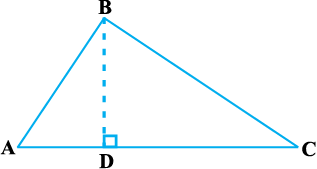
Fig. 6.46
We are given a right triangle ABC right angled at B.
We need to prove that AC2 = AB2 + BC2
Let us draw BD ⊥ AC (see Fig. 6.46).
Now, ∆ ADB ~ ∆ ABC (Theorem 6.7)
So,  =
=  (Sides are proportional)
(Sides are proportional)
or, AD . AC = AB2 (1)
Also, ∆ BDC ~ ∆ ABC (Theorem 6.7)
So,  =
= 
or, CD . AC = BC2 (2)
Adding (1) and (2),
AD . AC + CD . AC = AB2 + BC2
or, AC (AD + CD) = AB2 + BC2
or, AC . AC = AB2 + BC2
or, AC2 = AB2 + BC2
The above theorem was earlier given by an ancient Indian mathematician Baudhayan (about 800 B.C.E.) in the following form :
The diagonal of a rectangle produces by itself the same area as produced by its both sides (i.e., length and breadth).
For this reason, this theorem is sometimes also referred to as the Baudhayan Theorem.
What about the converse of the Pythagoras Theorem? You have already verified, in the earlier classes, that this is also true. We now prove it in the form of a theorem.
Theorem 6.9 :
In a triangle, if square of one side is equal to the sum of the squares of the other two sides, then the angle opposite the first side is a right angle.
Proof :
Here, we are given a triangle ABC in which AC2 = AB2 + BC2.
We need to prove that ∠ B = 90°.
To start with, we construct a ∆ PQR right angled at Q such that PQ = AB and QR = BC (see Fig. 6.47).
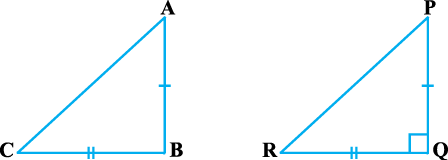
Fig. 6.47
Now, from ∆ PQR, we have :
PR2 = PQ2 + QR2 (Pythagoras Theorem,
as ∠ Q = 90°)
or, PR2 = AB2 + BC2 (By construction) (1)
But AC2 = AB2 + BC2 (Given) (2)
So, AC = PR [From (1) and (2)] (3)
Now, in ∆ ABC and ∆ PQR,
AB = PQ (By construction)
BC = QR (By construction)
AC = PR [Proved in (3) above]
So, ∆ ABC ≅ ∆ PQR (SSS congruence)
Therefore, ∠ B = ∠ Q (CPCT)
But ∠ Q = 90° (By construction)
So, ∠ B = 90°
Note : Also see Appendix 1 for another proof of this theorem.
Let us now take some examples to illustrate the use of these theorems.
Example 10 :
In Fig. 6.48, ∠ ACB = 90° and CD ⊥ AB. Prove that 
Solution :
∆ ACD ~ ∆ ABC (Theorem 6.7)
So,  =
= 
or, AC2 = AB . AD (1)
Similarly, ∆ BCD ~ ∆ BAC (Theorem 6.7)
So,  =
= 
or, BC2 = BA . BD (2)
Therefore, from (1) and (2),
 =
= 
Example 11 :
A ladder is placed against a wall such that its foot is at a distance of 2.5 m from the wall and its top reaches a window 6 m above the ground. Find the length of the ladder.
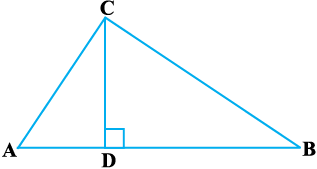
Fig. 6.48
Solution :
Let AB be the ladder and CA be the wall with the window at A (see Fig. 6.49).
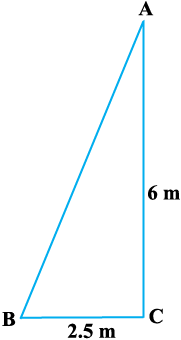
Fig. 6.49
Also, BC = 2.5 m and CA = 6 m
From Pythagoras Theorem, we have:
AB2 = BC2 + CA2
= (2.5)2 + (6)2
= 42.25
So, AB = 6.5
Thus, length of the ladder is 6.5 m.
Example 12 :
In Fig. 6.50, if AD ⊥ BC, prove that AB2 + CD2 = BD2 + AC2.
Solution :
From ∆ ADC, we have
AC2 = AD2 + CD2
(Pythagoras Theorem) (1)
From ∆ ADB, we have
AB2 = AD2 + BD2
(Pythagoras Theorem) (2)
Subtracting (1) from (2), we have
AB2 – AC2 = BD2 – CD2
or, AB2 + CD2 = BD2 + AC2
Example 13 :
BL and CM are medians of a triangle ABC right angled at A. Prove that
4 (BL2 + CM2) = 5 BC2.
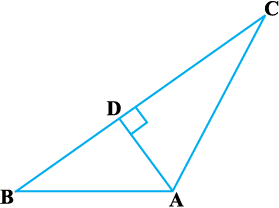
Fig. 6.50
Solution :
BL and CM are medians of the
∆ ABC in which ∠ A = 90° (see Fig. 6.51).
From ∆ ABC,
BC2 = AB2 + AC2 (Pythagoras Theorem) (1)
From ∆ ABL,
BL2 = AL2 + AB2
or, BL2 =  (L is the mid-point of AC)
(L is the mid-point of AC)
or, BL2 = 
or, 4 BL2 = AC2 + 4 AB2 (2)
From ∆ CMA,
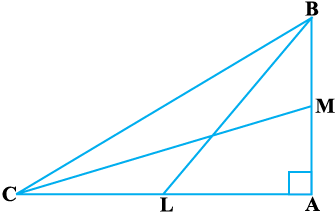
Fig. 6.51
CM2 = AC2 + AM2
or, CM2 = AC2 +  (M is the mid-point of AB)
(M is the mid-point of AB)
or, CM2 = AC2 + 
or 4 CM2 = 4 AC2 + AB2 (3)
Adding (2) and (3), we have
4 (BL2 + CM2) = 5 (AC2 + AB2)
i.e., 4 (BL2 + CM2) = 5 BC2 [From (1)]
Example 14 :
O is any point inside a rectangle ABCD (see Fig. 6.52). Prove that OB2 + OD2 = OA2 + OC2.
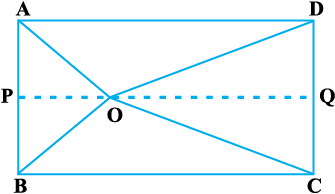
Fig. 6.52
Solution :
Through O, draw PQ || BC so that P lies on AB and Q lies on DC.
Now, PQ || BC
Therefore, PQ ⊥ AB and PQ ⊥ DC (∠ B = 90° and ∠ C = 90°)
So, ∠ BPQ = 90° and ∠ CQP = 90°
Therefore, BPQC and APQD are both rectangles.
Now, from ∆ OPB,
OB2 = BP2 + OP2 (1)
Similarly, from ∆ OQD,
OD2 = OQ2 + DQ2 (2)
From ∆ OQC, we have
OC2 = OQ2 + CQ2 (3)
and from ∆ OAP, we have
OA2 = AP2 + OP2 (4)
Adding (1) and (2),
OB2 + OD2 = BP2 + OP2 + OQ2 + DQ2
= CQ2 + OP2 + OQ2 + AP2
(As BP = CQ and DQ = AP)
= CQ2 + OQ2 + OP2 + AP2
= OC2 + OA2 [From (3) and (4)]
Exercise 6.5
1. Sides of triangles are given below. Determine which of them are right triangles. In case of a right triangle, write the length of its hypotenuse.
(i) 7 cm, 24 cm, 25 cm
(ii) 3 cm, 8 cm, 6 cm
(iii) 50 cm, 80 cm, 100 cm
(iv) 13 cm, 12 cm, 5 cm
2. PQR is a triangle right angled at P and M is a point on QR such that PM ⊥ QR. Show that PM2 = QM . MR.
3. In Fig. 6.53, ABD is a triangle right angled at A and AC ⊥ BD. Show that

Fig. 6.53
(i) AB2 = BC . BD
(ii) AC2 = BC . DC
(iii) AD2 = BD . CD
4. ABC is an isosceles triangle right angled at C. Prove that AB2 = 2AC2.
5. ABC is an isosceles triangle with AC = BC. If AB2 = 2 AC2, prove that ABC is a right triangle.
6. ABC is an equilateral triangle of side 2a. Find each of its altitudes.
7. Prove that the sum of the squares of the sides of a rhombus is equal to the sum of the squares of its diagonals.
8. In Fig. 6.54, O is a point in the interior of a triangle ABC, OD ⊥ BC, OE ⊥ AC and OF ⊥ AB. Show that
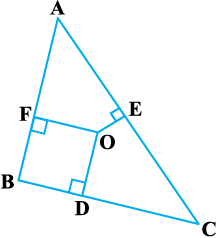
Fig. 6.54
(i) OA2 + OB2 + OC2 – OD2 – OE2 – OF2 = AF2 + BD2 + CE2,
(ii) AF2 + BD2 + CE2 = AE2 + CD2 + BF2.
9. A ladder 10 m long reaches a window 8 m above the ground. Find the distance of the foot of the ladder from base of the wall.
10. A guy wire attached to a vertical pole of height 18 m is 24 m long and has a stake attached to the other end. How far from the base of the pole should the stake be driven so that the wire will be taut?
11. An aeroplane leaves an airport and flies due north at a speed of 1000 km per hour. At the same time, another aeroplane leaves the same airport and flies due west at a speed of 1200 km per hour. How far apart will be the two planes after  hours?
hours?
12. Two poles of heights 6 m and 11 m stand on a plane ground. If the distance between the feet of the poles is 12 m, find the distance between their tops.
13. D and E are points on the sides CA and CB respectively of a triangle ABC right angled at C. Prove that AE2 + BD2 = AB2 + DE2.
14. The perpendicular from A on side BC of a ∆ ABC intersects BC at D such that DB = 3 CD (see Fig. 6.55). Prove that 2 AB2 = 2 AC2 + BC2.
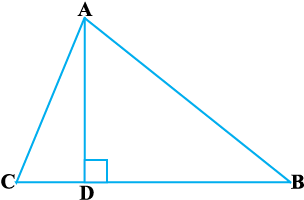
Fig. 6.55
15. In an equilateral triangle ABC, D is a point on side BC such that BD =  BC. Prove that 9 AD2 = 7 AB2.
BC. Prove that 9 AD2 = 7 AB2.
16. In an equilateral triangle, prove that three times the square of one side is equal to four times the square of one of its altitudes.
17. Tick the correct answer and justify : In ∆ ABC, AB =  cm, AC = 12 cm and BC = 6 cm. The angle B is :
cm, AC = 12 cm and BC = 6 cm. The angle B is :
(A) 120° (B) 60°
(C) 90° (D) 45°
Exercise 6.6 (Optional)*
1. In Fig. 6.56, PS is the bisector of ∠ QPR of ∆ PQR. Prove that 
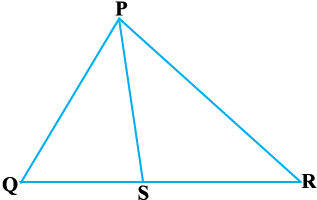
Fig. 6.56
2. In Fig. 6.57, D is a point on hypotenuse AC of ∆ ABC, such that BD ⊥ AC, DM ⊥ BC and DN ⊥ AB. Prove that :
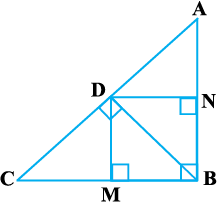
Fig. 6.57
(i) DM2 = DN . MC (ii) DN2 = DM . AN
3. In Fig. 6.58, ABC is a triangle in which ∠ ABC > 90° and AD ⊥ CB produced. Prove that AC2 = AB2 + BC2 + 2 BC . BD.
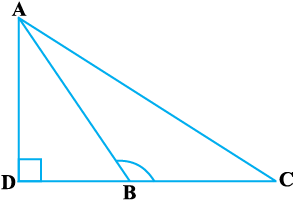
Fig. 6.58
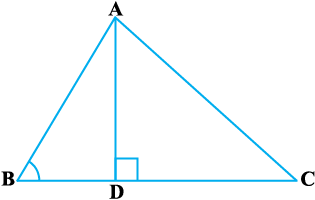
Fig. 6.59
4. In Fig. 6.59, ABC is a triangle in which ∠ ABC < 90° and AD ⊥ BC. Prove that
AC2 = AB2 + BC2 – 2 BC . BD.
5. In Fig. 6.60, AD is a median of a triangle ABC and AM ⊥ BC. Prove that :
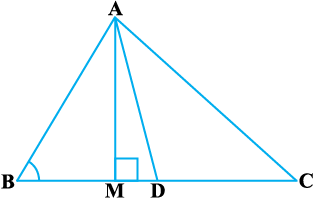
Fig. 6.60
(i) AC2 = AD2 + BC . DM + 
(ii) AB2 = AD2 – BC . DM +  (iii) AC2 + AB2 = 2 AD2 +
(iii) AC2 + AB2 = 2 AD2 +  BC2
BC2
6. Prove that the sum of the squares of the diagonals of parallelogram is equal to the sum of the squares of its sides.
7. In Fig. 6.61, two chords AB and CD intersect each other at the point P. Prove that :
(i) ∆ APC ~ ∆ DPB (ii) AP . PB = CP . DP
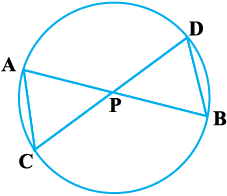
Fig. 6.61
8. In Fig. 6.62, two chords AB and CD of a circle intersect each other at the point P (when produced) outside the circle. Prove that
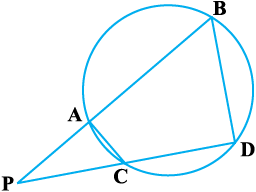
Fig. 6.62
* These exercises are not from examination point of view.
(i) ∆ PAC ~ ∆ PDB (ii) PA . PB = PC . PD
9. In Fig. 6.63, D is a point on side BC of ∆ ABC such that  Prove that AD is the bisector of ∠ BAC.
Prove that AD is the bisector of ∠ BAC.

Fig. 6.63
10. Nazima is fly fishing in a stream. The tip of her fishing rod is 1.8 m above the surface of the water and the fly at the end of the string rests on the water 3.6 m away and 2.4 m from a point directly under the tip of the rod. Assuming that her string (from the tip of her rod to the fly) is taut, how much string does she have out
(see Fig. 6.64)? If she pulls in the string at the rate of 5 cm per second, what will be the horizontal distance of the fly from her after 12 seconds?
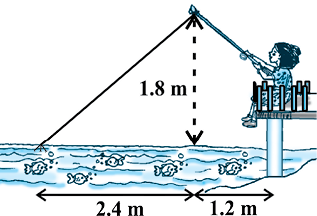
Fig. 6.64
6.7 Summary
In this chapter you have studied the following points :
1. Two figures having the same shape but not necessarily the same size are called similar figures.
2. All the congruent figures are similar but the converse is not true.
3. Two polygons of the same number of sides are similar, if (i) their corresponding angles are equal and (ii) their corresponding sides are in the same ratio (i.e., proportion).
4. If a line is drawn parallel to one side of a triangle to intersect the other two sides in distinct points, then the other two sides are divided in the same ratio.
5. If a line divides any two sides of a triangle in the same ratio, then the line is parallel to the third side.
6. If in two triangles, corresponding angles are equal, then their corresponding sides are in the same ratio and hence the two triangles are similar (AAA similarity criterion).
7. If in two triangles, two angles of one triangle are respectively equal to the two angles of the other triangle, then the two triangles are similar (AA similarity criterion).
8. If in two triangles, corresponding sides are in the same ratio, then their corresponding angles are equal and hence the triangles are similar (SSS similarity criterion).
9. If one angle of a triangle is equal to one angle of another triangle and the sides including these angles are in the same ratio (proportional), then the triangles are similar (SAS similarity criterion).
10. The ratio of the areas of two similar triangles is equal to the square of the ratio of their corresponding sides.
11. If a perpendicular is drawn from the vertex of the right angle of a right triangle to the hypotenuse, then the triangles on both sides of the perpendicular are similar to the whole triangle and also to each other.
12. In a right triangle, the square of the hypotenuse is equal to the sum of the squares of the other two sides (Pythagoras Theorem).
13. If in a triangle, square of one side is equal to the sum of the squares of the other two sides, then the angle opposite the first side is a right angle.
A Note to the Reader
If in two right triangles, hypotenuse and one side of one triangle are proportional to the hypotenuse and one side of the other triangle, then the two triangles are similar. This may be referred to as the RHS Similarity Criterion.
If you use this criterion in Example 2, Chapter 8, the proof will become simpler.
